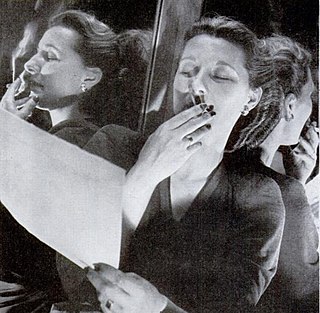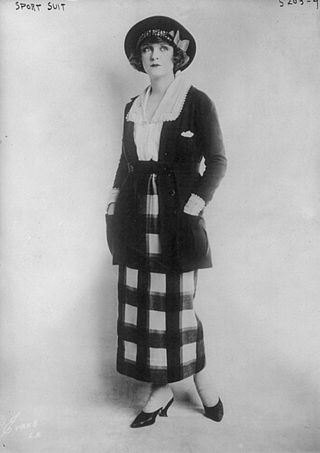Antony Price is an English fashion designer best known for evening wear and suits, and for being as much an "image-maker" as a designer. He has collaborated with a number of high-profile musicians, including David Bowie, Robert Palmer, Iva Davies, Steve Strange, and Duran Duran, but especially Bryan Ferry and Roxy Music, whose look was defined by Price's designs. The manner in which Price dressed – or in many cases, undressed – the "Roxy girls" on the covers of their albums helped to define the band's pop retro-futurism.

Occupational therapy (OT) is a healthcare profession that involves the use of assessment, intervention, consultation, and coaching to develop, recover, or maintain meaningful occupations of individuals, groups, or communities. The field of OT consists of health care practitioners trained and educated to support mental health and physical performance. Occupational therapists specialize in teaching, educating, and supporting participation in activities that occupy an individual's time. It is an independent health profession sometimes categorized as an allied health profession and consists of occupational therapists (OTs) and occupational therapy assistants (OTAs). OTs and OTAs have different roles, with OTs licensed to complete comprehensive occupational therapy evaluations. Both professionals work with people who want to improve their ability to participate in meaningful occupations.

Thomas Jacob Hilfiger is an American fashion designer and the founder of Tommy Hilfiger Corporation.

Sir Norman Bishop Hartnell was a leading British fashion designer, best known for his work for the ladies of the royal family. Hartnell gained the Royal Warrant as Dressmaker to Queen Elizabeth in 1940, and Royal Warrant as Dressmaker to Queen Elizabeth II in 1957. Princess Beatrice also wore a dress designed for Queen Elizabeth II by Hartnell for her wedding in 2020.

Nicole Miller is an American fashion designer and businesswoman.
Eri Matsui is a Japanese fashion designer known for mathematically inspired designs.

History of fashion design refers specifically to the development of the purpose and intention behind garments, shoes, accessories, and their design and construction. The modern industry, based around firms or fashion houses run by individual designers, started in the 19th century with Charles Frederick Worth who, beginning in 1858, was the first designer to have his label sewn into the garments he created.

Fashion design is the art of applying design, aesthetics, clothing construction and natural beauty to clothing and its accessories. It is influenced by culture and different trends and has varied over time and place. "A fashion designer creates clothing, including dresses, suits, pants, and skirts, and accessories like shoes and handbags, for consumers. He or she can specialize in clothing, accessory, or jewelry design, or may work in more than one of these areas."

Bonnie Cashin was an American fashion designer. Considered a pioneer in the design of American sportswear, she created innovative, uncomplicated clothing that catered to the modern, independent woman beginning in the post-war era through to her retirement from the fashion world in 1985.

Anti-fashion is an umbrella term for various styles of dress that are explicitly contrary to the fashion of the day. Anti-fashion styles may represent an attitude of indifference or may arise from political or practical goals which make fashion a secondary priority. The term is sometimes even used for styles championed by high-profile designers, when they encourage or create trends that do not follow the mainstream fashion of the time.

Elizabeth Hawes was an American clothing designer, outspoken critic of the fashion industry, and champion of ready to wear and people's right to have the clothes they desired, rather than the clothes dictated to be fashionable, an idea encapsulated in her book Fashion Is Spinach, published in 1938. She was among the first American apparel designers to establish their reputations outside of Paris haute couture. In addition to her work in the fashion industry as a sketcher, copyist, stylist, and journalist, and designer, she was an author, union organizer, champion of gender equality, and political activist.

Clare Potter was a fashion designer who was born in Jersey City, New Jersey in 1903. In the 1930s she was one of the first American fashion designers to be promoted as an individual design talent. Working under her elided name Clarepotter, she has been credited as one of the inventors of American sportswear. Based in Manhattan, she continued designing through the 1940s and 1950s. Her clothes were renowned for being elegant, but easy-to-wear and relaxed, and for their distinctive use of colour. She founded a ready-to-wear fashion company in Manhattan named Timbertop in 1948, and in the 1960s she also established a wholesale company to manufacture fashions. Potter was one of the 17 women gathered together by Edna Woolman Chase, editor-in-chief of Vogue to form the Fashion Group International, Inc., in 1928.

Sportswear is an American fashion term originally used to describe separates, but which since the 1930s has come to be applied to day and evening fashions of varying degrees of formality that demonstrate a specific relaxed approach to their design, while remaining appropriate for a wide range of social occasions. The term is not necessarily synonymous with activewear, clothing designed specifically for participants in sporting pursuits. Although sports clothing was available from European haute couture houses and "sporty" garments were increasingly worn as everyday or informal wear, the early American sportswear designers were associated with ready-to-wear manufacturers. While most fashions in America in the early 20th century were directly copied from, or influenced heavily by Paris, American sportswear became a home-grown exception to this rule, and could be described as the American Look. Sportswear was designed to be easy to look after, with accessible fastenings that enabled a modern emancipated woman to dress herself without a maid's assistance.

Yeohlee Teng is an American fashion designer originally from Malaysia and of Chinese heritage. She received the Smithsonian's Cooper-Hewitt National Design Award for fashion design in 2004. Her work has been displayed at the Metropolitan Museum of Art, New York and Victoria & Albert, London.
Sabine Seymour is a designer, author, entrepreneur, and researcher, known for her work in fashionable technology and design. She is the director of the Fashionable Technology Lab and Assistant Professor of Fashionable Technology at Parsons the New School for Design. Seymour is the founder of Moondial Inc., a consulting company specializing in the integration of technology and fabrics.

Digital Fashion is a field of fashion design that relies on 3D software or artificial intelligence to produce hyper-realistic, data-intensive digital 3D garment simulations that are digital-only products or digital models for physical products. Digital garments can be worn and presented in virtual environments, social media, online gaming, virtual reality (VR), and augmented reality (AR) platforms. The field contributes to the development of a more sustainable future for the fashion industry It has often been praised as an answer to ethical and creative concerns of traditional fashion by promoting innovation, reducing waste, and encouraging conscious consumption.
Sarah Jawaid, better known by her label name Sarah Gandapur, is a popular Pakistani fashion designer and Fashion journalist. She rose to prominence by exhibiting number of fashion shows and fashion weeks. She also debuted as a costume designer for films and was awarded ARY Film Award for Best Costume Design for Chambaili.
Silverts Adaptive Clothing & Footwear, is a U.S. and Canadian based retailer that designs and distributes adaptive clothing and footwear for men and women. The company makes adaptive apparel that creates easy dressing solutions for people living with lowered mobility. Some of the variety of Silverts adaptive clothing includes clothing for wheelchair users, caregiver assisted clothing such as open back tops, easy access clothing with magnetic closures, as well as adaptive shoes, socks and slippers designed to assist people with lowered mobility in their daily dressing and undressing.

Karl Davis was an African-American fashion designer once called one of New York's most promising young designers. Davis had six major collections, the last shown at the Manhattan restaurant Caffe Roma.

Adrienne Steckling-Coen (1934-2006), known as Adri, was an American fashion designer whose label, Adri, was particularly successful in the 1970s-1980s.














